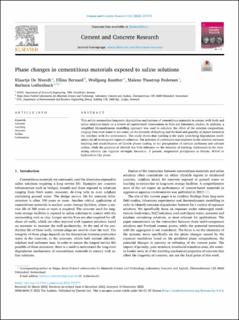| dc.contributor.author | Weerdt, Klaartje de | |
| dc.contributor.author | Bernard, Ellina | |
| dc.contributor.author | Kunther, Wolfgang | |
| dc.contributor.author | Pedersen, Malene Thostrup | |
| dc.contributor.author | Lothenbach, Barbara | |
| dc.date.accessioned | 2023-03-30T06:49:13Z | |
| dc.date.available | 2023-03-30T06:49:13Z | |
| dc.date.created | 2023-03-09T10:19:50Z | |
| dc.date.issued | 2023 | |
| dc.identifier.citation | Cement and Concrete Research. 2023, 165 . | en_US |
| dc.identifier.issn | 0008-8846 | |
| dc.identifier.uri | https://hdl.handle.net/11250/3061018 | |
| dc.description.abstract | This article summarizes long-term degradation mechanisms of cementitious materials in contact with fresh and saline solutions based on a review of experimental observations in field and laboratory studies. In addition, a simplified thermodynamic modelling approach was used to calculate the effect of the solution composition, ranging from river water to sea water, on the intensity of leaching and the kind and quantity of phases formed at the interface with the environment. This study shows that leaching is the main underlying degradation mechanism for all investigated exposure solutions. The presence of carbonates and sulphates in the solution increases leaching and decalcification of Ca-rich phases leading to the precipitation of calcium carbonate and calcium sulfate, while the presence of chloride has little influence on the intensity of leaching. Carbonates in the interacting solution can suppress ettringite formation. If present, magnesium precipitates as brucite, M-S-H or hydrotalcite-like phase. | en_US |
| dc.language.iso | eng | en_US |
| dc.publisher | Elsevier | en_US |
| dc.rights | Navngivelse 4.0 Internasjonal | * |
| dc.rights.uri | http://creativecommons.org/licenses/by/4.0/deed.no | * |
| dc.title | Phase changes in cementitious materials exposed to saline solutions | en_US |
| dc.title.alternative | Phase changes in cementitious materials exposed to saline solutions | en_US |
| dc.type | Peer reviewed | en_US |
| dc.type | Journal article | en_US |
| dc.description.version | publishedVersion | en_US |
| dc.source.pagenumber | 0 | en_US |
| dc.source.volume | 165 | en_US |
| dc.source.journal | Cement and Concrete Research | en_US |
| dc.identifier.doi | 10.1016/j.cemconres.2022.107071 | |
| dc.identifier.cristin | 2132667 | |
| cristin.ispublished | true | |
| cristin.fulltext | original | |
| cristin.qualitycode | 2 | |

